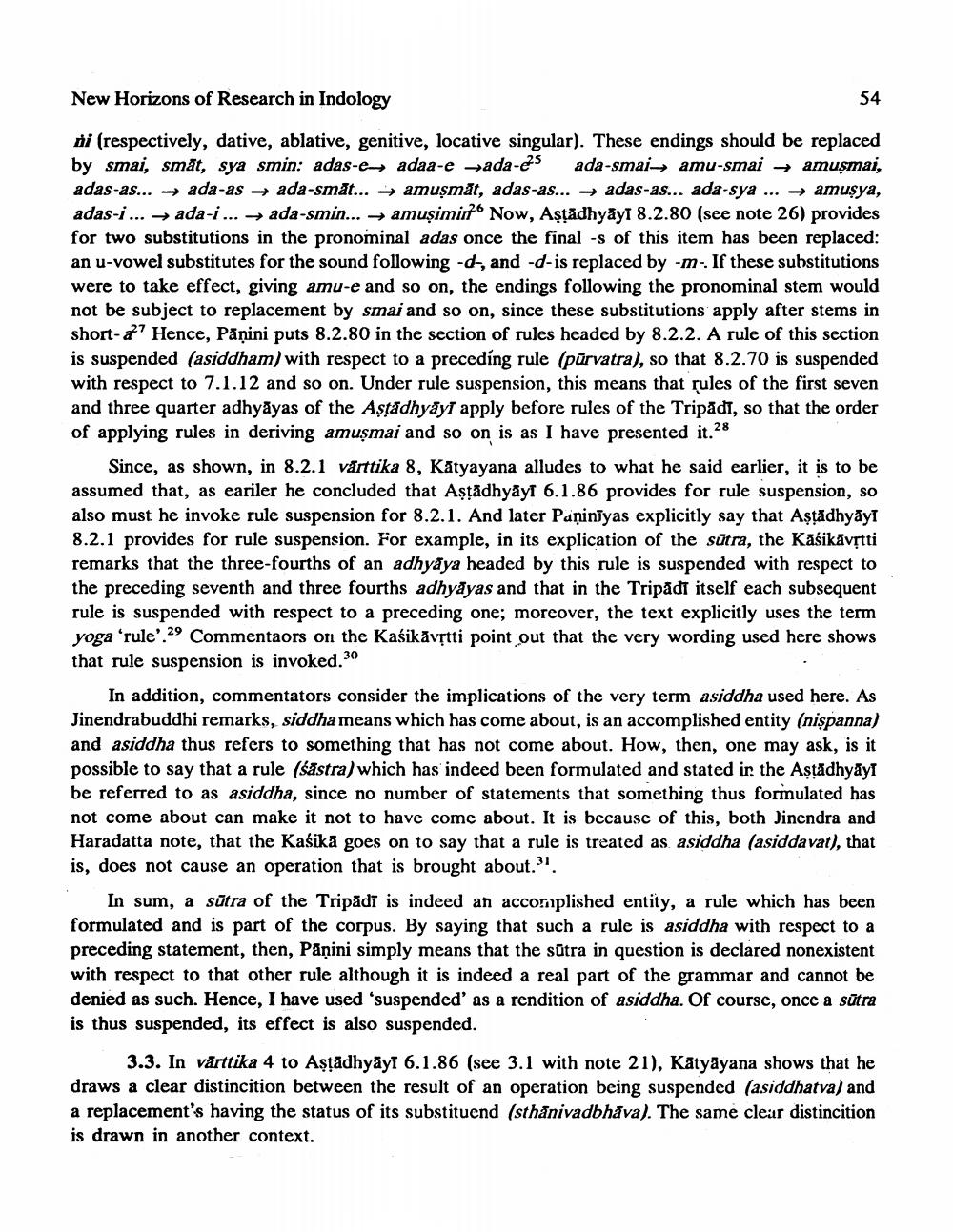________________
New Horizons of Research in Indology
54
di (respectively, dative, ablative, genitive, locative singular). These endings should be replaced by smai, smat, sya smin: adas-e-> adaa-e -ada-es ada-smai - amu-smai → amuşmai, adas-as... ada-as → ada-smat... → amuşmát, adas-as... → adas-as... ada-sya ... → amuşya, adas-i... → ada-i... → ada-smin... → amușimir? Now, Aştadhyayi 8.2.80 (see note 26) provides for two substitutions in the pronominal adas once the final -s of this item has been replaced: an u-vowel substitutes for the sound following -d, and -d-is replaced by -m-. If these substitutions were to take effect, giving amu-e and so on, the endings following the pronominal stem would not be subject to replacement by smai and so on, since these substitutions apply after stems in short-a Hence, Pāṇini puts 8.2.80 in the section of rules headed by 8.2.2. A rule of this section is suspended (asiddham) with respect to a preceding rule (pūrvatra), so that 8.2.70 is suspended with respect to 7.1.12 and so on. Under rule suspension, this means that rules of the first seven and three quarter adhyāyas of the Astădhyay apply before rules of the Tripadt, so that the order of applying rules in deriving amuşmai and so on is as I have presented it.28
Since, as shown, in 8.2.1 vårttika 8, Katyayana alludes to what he said earlier, it is to be assumed that, as eariler he concluded that Așțădhyāyf 6.1.86 provides for rule suspension, so also must he invoke rule suspension for 8.2.1. And later Paņinīyas explicitly say that Aștādhyāyr 8.2.1 provides for rule suspension. For example, in its explication of the sūtra, the Kašikāvștti remarks that the three-fourths of an adhyaya headed by this rule is suspended with respect to the preceding seventh and three fourths adhyayas and that in the Tripadt itself each subsequent rule is suspended with respect to a preceding one; moreover, the text explicitly uses the term yoga 'rule'.29 Commentaors on the Kaśikāvstti point out that the very wording used here shows that rule suspension is invoked. 30
In addition, commentators consider the implications of the very term asiddha used here. As Jinendrabuddhi remarks, siddha means which has come about, is an accomplished entity (nişpanna) and asiddha thus refers to something that has not come about. How, then, one may ask, is it possible to say that a rule (śästra) which has indeed been formulated and stated ir, the Astādhyāyi be referred to as asiddha, since no number of statements that something thus formulated has not come about can make it not to have come about. It is because of this, both Jinendra and Haradatta note, that the Kaśikā goes on to say that a rule is treated as asiddha (asiddavat), that is, does not cause an operation that is brought about.?!.
In sum, a sūtra of the Tripādt is indeed an accomplished entity, a rule which has been formulated and is part of the corpus. By saying that such a rule is asiddha with respect to a preceding statement, then, Påņini simply means that the sūtra in question is declared nonexistent with respect to that other rule although it is indeed a real part of the grammar and cannot be denied as such. Hence, I have used 'suspended as a rendition of asiddha. Of course, once a sūtra is thus suspended, its effect is also suspended.
3.3. In vårttika 4 to Astādhyāyt 6.1.86 (see 3.1 with note 21), Katyāyana shows that he draws a clear distincition between the result of an operation being suspended (asiddhatva) and a replacement's having the status of its substituend (sthanivadbhava). The same clear distincition is drawn in another context.




